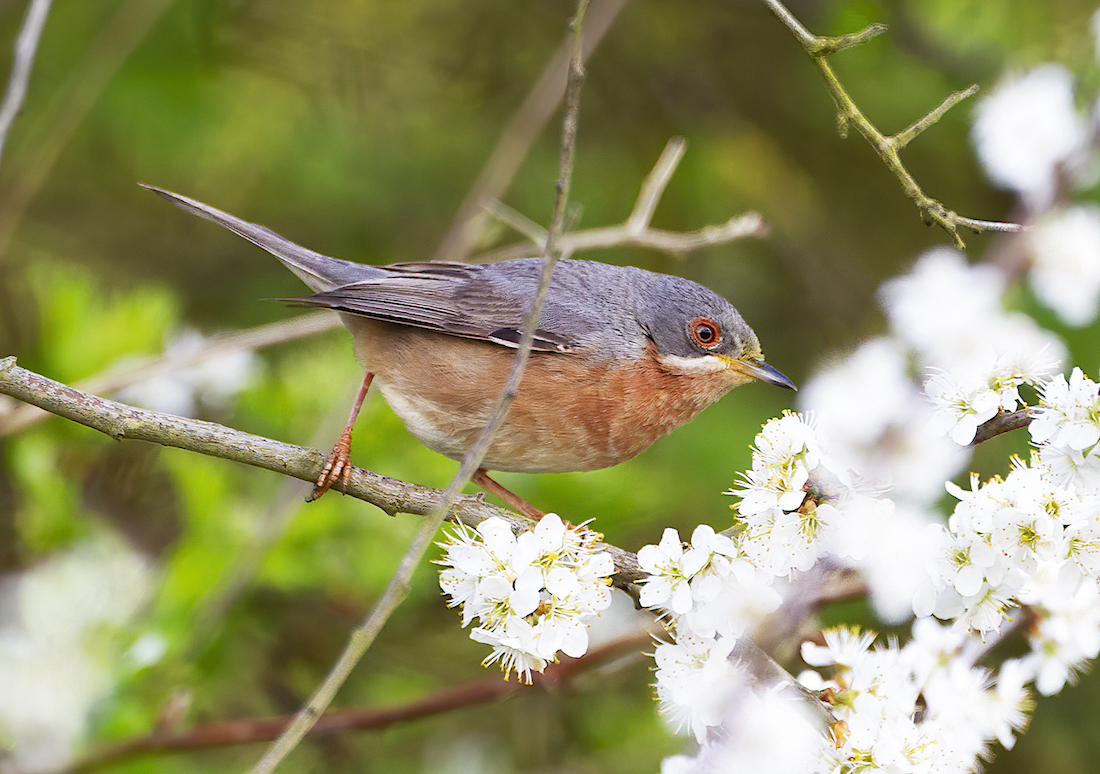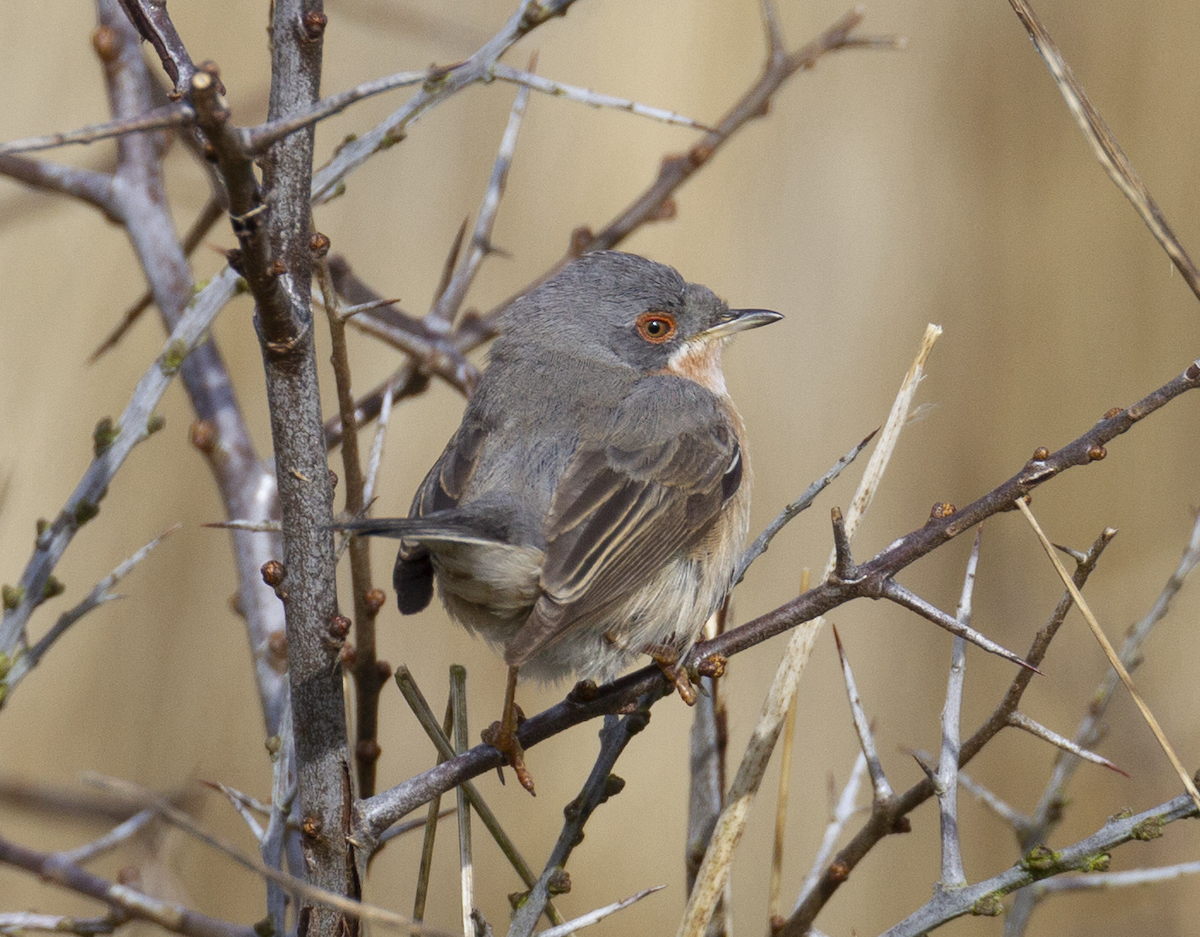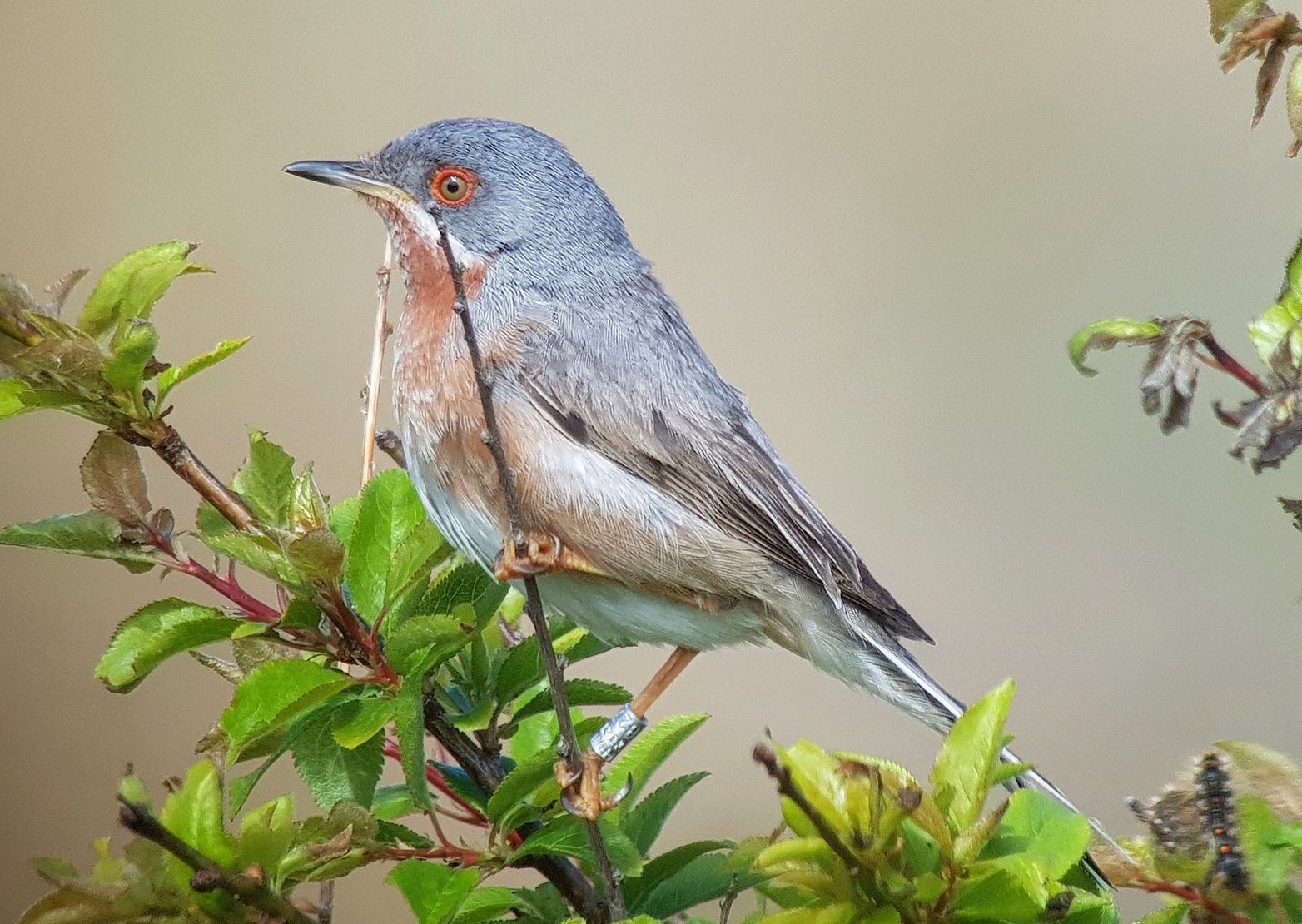Subalpine Warbler Curruca cantillans
Very rare vagrant, with nine county records. The first was on 11th May 1970 at Ingoldmells Point, the most recent on 20th-23rd April 2013 at Gibraltar Point. All taxa in the Subalpine warbler complex are considered by BBRC.



Western Subalpine Warblers, left and centre: Humberston 3rd April 2011 and Gibraltar Point NNR April 20th 2013(Graham Catley);
right, Eastern Subalpine Warbler Gibraltar Point April 29th 2019
Taxonomic note
The Subalpine Warbler group currently consists of three species after a taxonomic review in 2020:
Moltoni’s Warbler Curruca subalpina, found on Mediterranean islands and in northern Italy;
Eastern Subalpine Warbler C. cantillans, which comprises two subspecies, nominate cantillans (central and southern Italy) and and albistriata (Greece, western Turkey and the Balkans and the north-east corner of Italy);
Western Subalpine Warbler C. iberiae, monotypic, and found in Iberia, southern France, extreme northwestern Italy, and also northwestern Africa from Morocco to Tunisia.
Due to these recent taxonomic changes and a lack of clarity over identification criteria, the proportion of historical records assignable to each species remains unclear. The occurrence in Britain of subalpina, cantillans and iberiae has now been confirmed by DNA analysis (Collinson et al. 2014). Further details of this complex situation are discussed by Stoddart et al. (2014) and Stoddart (2022) and on the BBRC website at www.bbrc.org.uk/subspecies-information/crows-to-warblers. Note that from 1st January 2019 all 'Subalpine Warbler' records are considered by BBRC, regardless of whether or not the sub-species has been ascertained. One certainty amidst this taxonomic flux is that Moltoni's Warbler has not yet occurred in Lincolnshire to the best of our knowledge. BBRC published a review of records in 2021, https://britishbirds.co.uk/content/rarities-committee%E2%80%99s-files%C2%A0bbrc-and-newly-split-species.
Update, August 2025
BBRC has no plans to conduct a review of the UK records of the Subalpine Warbler. Reasons include identification criteria being in flux; variation in the usefulness of tail pattern (often very useful in male Eastern Subalpine, less useful for female Western Subalpine); further uncertainty regarding the specific status of Moltoni's Warbler (island forms to be split from mainland form?); usefulness of wing shape as a supporting character uncertain; usefulness of calls also variable - a 'clincher' in the case of Moltoni's, but are calls of Western-type Subalpines ever a solid feature?
As a result, the records here will reamain as published. We have no reason or possibility of looking beyond the original submissions, which were submitted in light of the known criteria at the time and before the taxonomy was updated. The 2019 record of an Eastern Subalpine Warbler remains the only record confirmed by DNA analysis.
County records
Of the ten records to date, nine have been in the spring between 3rd April and 28th June, and just one in the autumn, a 1CY female trapped at Theddlethorpe on 15th September 1996. Given the current taxonomic uncertainty and proposed split of the Subalpine Warblers into Western Subalpine S. inornata and Eastern Subalpine S. cantillans, and the recent split from the others of Moltoni's Warbler S. subalpina (western Mediterranean and northwest Italy), BBRC are reviewing all Lincolnshire and UK records. All of the county records are summarised in the three tables below as Subalpine Warbler (unassigned); Western Subalpine Warbler; Eastern Subalpine Warbler. These have been reviewed by the Records Committee from sketches or photographs of the birds concerned in the orignal BBRC submissions and are assigned as such to the best of our knowledge, although the situation may change as and when the BBRC review is completed.
One additional note concerns the Eastern Subalpine Warbler trapped at Gibraltar Point NNR in April 2019. Material for DNA analysis was obtained when the bird was trapped and the DNA sequencing confirmed it's identity (details on file for reference).
Subalpine Warbler (unassigned), Curruca sp.
| Site | First date | Last date | Count | Notes |
| Ingoldmells Point | 11/05/1970 | - | 1 | Singing male. |
| Tetney | 14/05/1976 | - | 1 | Adult male, trapped. |
| Gibraltar Point NNR | 07/05/1983 | 14/05/1983 | 1 | Adult female, trapped. |
| Pye's Hall, Donna Nook | 23/05/1985 | - | 1 | Singing male. |
| Saltfleetby-Theddlethorpe NNR | 28/06/1994 | - | 1 | 2CY male, trapped. |
| Crook Bank, Saltfleetby-Theddlethorpe NNR | 15/09/1996 | - | 1 | 1CY female, trapped. |
| Saltfleet Haven | 06/05/2023 | - | 1 | 2CY+ male, trapped. Wester/Eastern Subalpine Warbler (BBRC 117: 664-736) |
Western Subalpine Warbler, Curruca iberiae
| Site | First date | Last date | Count | Notes |
| Humberston | 03/04/2011 | - | 1 | Adult male |
| Gibraltar Point NNR | 20/04/2013 | 23/04/2013 | 1 | 2CY male |
Eastern Subalpine Warbler, C. cantillans
| Site | First date | Last date | Count | Notes |
| Humberston | 12/05/2011 | 13/05/1981 | 1 | Adult male |
| Gibraltar Point NNR | 29/04/2019 | 30/04/2019 | 1 | Adult male, trapped. Confirmed by DNA analysis |
References
British Birds Rarities Committee: List changes, 1st January 2019. All 'Subalpine Warbler' records to be assessed by the British Birds Rarities committee. https://www.bbrc.org.uk/1907
Collinson, J. M., McGowan, R.Y. and Irestedt, M. 2014. First British records of ‘Eastern’ and ‘Western’ Subalpine Warblers. British Birds 107: 282-285.
Stoddart, A. on behalf of BBRC (2014) Assessing and recording Subalpine Warblers. British Birds 107: 420-424.
Stoddart, A. (2022). Subalpine Warblers ID guide. https://www.birdguides.com/articles/identification/subalpine-warblers-photo-id-guide/
(Updated with reference to the new Birds of Lincolnshire (2021) November 2022)

